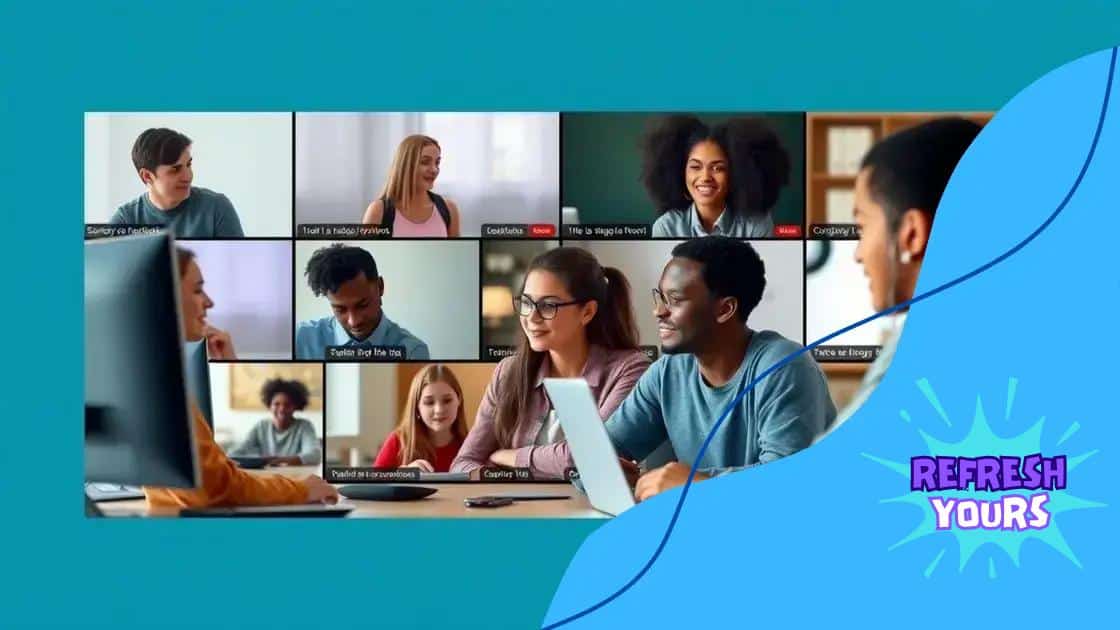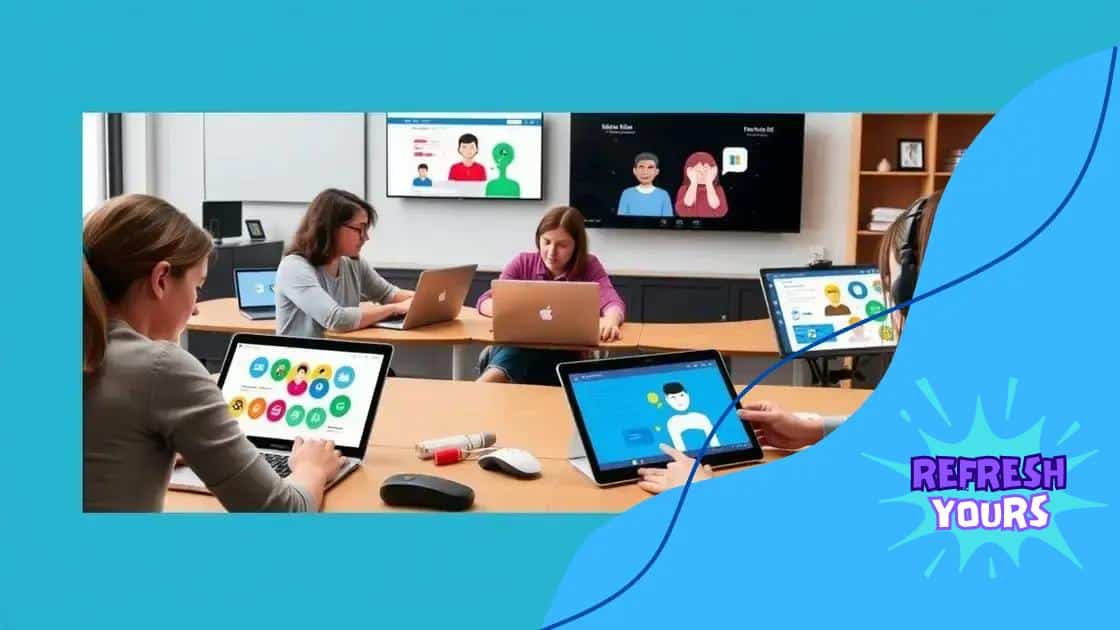The impact of virtual classrooms on student collaboration

The impact of virtual classrooms on student collaboration enhances learning through flexible connections, diverse perspectives, and the use of innovative tools, while addressing challenges like technological access and engagement.
The impact of virtual classrooms on student collaboration is reshaping how learners connect and work together. Have you ever wondered how this digital shift influences teamwork among students? Let’s dive in.
Understanding virtual classrooms
Understanding virtual classrooms is essential in today’s educational landscape. These digital spaces have transformed how students interact and learn. Virtual classrooms offer a unique opportunity for teachers and students to connect, regardless of their physical location. This flexibility is crucial as it accommodates various learning styles and needs.
What are virtual classrooms?
Virtual classrooms are online environments where instructors and students engage through video conferencing, chat, and digital educational tools. These platforms recreate the traditional classroom experience in a digital format. Students can participate in discussions, collaborate on projects, and access resources from anywhere.
Benefits of virtual classrooms
- Increased accessibility for students; they can learn from home or any location with internet access.
- Flexible scheduling, allowing learners to balance their studies with other responsibilities.
- Opportunities for diverse learning resources, enhancing the educational experience.
- Enhanced collaboration through various digital tools that facilitate group work.
In a virtual classroom, students often use tools like video calls, chat rooms, and collaborative documents. These resources enable them to share ideas and support each other’s learning processes. For example, using Google Docs allows students to work together on assignments in real-time, which promotes teamwork skills.
However, understanding virtual classrooms also involves recognizing the challenges they may present. Some students might struggle with distractions at home or lack access to reliable internet. These barriers can affect their engagement and success in online learning environments. It’s crucial for educators to find ways to support all students, addressing these challenges head-on.
Overall, the concept of virtual classrooms is continually evolving. As technology advances, so too will the ways in which students and teachers interact. The ongoing development of these platforms will likely lead to even more innovative teaching strategies that can enhance the learning experience further.
Benefits of collaboration in virtual settings
The benefits of collaboration in virtual settings are numerous and impactful. In a virtual environment, students can work together from anywhere, which fosters a sense of community among peers. This collaboration can lead to rich discussions, diverse perspectives, and enhanced learning experiences.
Enhanced Interaction
Collaboration in virtual classrooms encourages students to engage more actively. Through tools like video calls and chat rooms, learners can easily share their thoughts and ideas. This interaction helps to build relationships and can even lead to friendships beyond academics.
Diverse Perspectives
- Learning from classmates with different backgrounds.
- Incorporating various approaches to problem-solving.
- Creating a richer educational experience through shared insights.
Additionally, students can benefit from combining their unique skills. In virtual projects, one student might excel at writing, while another is great at research. By collaborating, they can complement each other’s strengths, resulting in better presentations and projects.
Furthermore, the ability to work together online trains students for future workplaces. Many careers today involve remote collaboration, so mastering this skill now can be invaluable later. They will learn to communicate effectively using digital tools and manage time across different tasks.
As students collaborate in virtual settings, it’s important to use appropriate online tools. Applications like Microsoft Teams and Zoom provide platforms for real-time communication and information sharing. This improves organization and ensures everyone stays on the same page.
In summary, the benefits of collaboration in virtual settings extend beyond immediate academic advantages. They prepare students for future teamwork in schools and careers alike, making it a crucial part of the modern educational experience.
Tools that enhance student collaboration

The right tools can significantly enhance student collaboration in virtual classrooms. Many platforms are designed to support teamwork, allowing students to connect, communicate, and work on projects together, no matter where they are located. Let’s explore some of these tools.
Communication Tools
Effective communication is vital for collaboration. Tools like Slack and Microsoft Teams enable students to chat, share files, and have video calls. These platforms help keep everyone in touch and connected during group projects.
Collaborative Document Editing
- Google Docs allows multiple users to edit documents in real time.
- Microsoft OneNote provides a shared workspace for taking notes and brainstorming.
- Padlet lets students create interactive boards for ideas and feedback.
These tools not only help students work together but also encourage creativity. For instance, while using Google Docs, students can see each other’s changes instantly, making it easier to collaborate on essays or reports.
Another great platform is Miro, which offers a digital whiteboard for brainstorming sessions. This tool allows students to visualize their ideas and organize thoughts effectively, making group discussions more productive.
Working with these collaborative tools helps students build essential skills, such as teamwork and communication. These skills are valuable not only in school but also in future job environments where remote collaboration is becoming the norm.
By integrating these tools into their learning experience, students can enhance their collaboration and achieve better outcomes. The possibilities are endless when they have the right resources!
Challenges faced in virtual classrooms
While virtual classrooms offer many advantages, they also come with unique challenges. Understanding these challenges can help educators and students find effective solutions. One of the main issues is technological access. Not all students have reliable internet or devices, which can create barriers to participation.
Isolation and Engagement
Another challenge is the feeling of isolation that some students may experience. In traditional classrooms, social interactions naturally occur, but in virtual settings, this can be lost. Students might feel disconnected from their peers, which can affect their motivation to engage in learning.
Distractions at Home
- Many students face interruptions from family members.
- They may have to manage household responsibilities.
- Some students find it hard to stay focused in a home environment.
Additionally, maintaining attention can be tough. The comfort of home often includes many distractions, making it harder for students to concentrate on their lessons. Teachers may notice that participation can drop when students are learning from home.
Furthermore, it’s essential to address differences in learning styles. Virtual classrooms may not accommodate every student’s needs. Some students thrive with face-to-face interactions, while others may prefer alone time for deeper focus. Adapting to these varied learning preferences in a virtual space can be a complex task for instructors.
Instructors can overcome these challenges by implementing effective strategies. Creating small breakout groups for discussions can encourage participation, helping students feel more connected. It’s also important to check in on students regularly to gauge their feelings and engagement, ensuring no one falls behind.
Future of virtual classrooms and collaboration
The future of virtual classrooms and collaboration looks promising as technology continues to evolve. Innovations in educational tools are making it easier for students to connect and learn effectively from anywhere in the world. This shift is creating new opportunities for collaborative learning experiences.
Emerging Technologies
Next-generation technologies, such as artificial intelligence and virtual reality, are set to revolutionize virtual classrooms. AI can personalize learning by adapting content to meet individual student needs, while virtual reality can immerse students in interactive environments that enhance understanding.
Global Collaboration
- Students from different countries can work together on projects.
- Collaborative platforms will support multilingual communication.
- Cross-cultural experiences will enrich learning.
Moreover, the future will see an increase in global collaboration. Students can participate in projects with peers worldwide, gaining diverse perspectives and learning from one another’s experiences. This global approach encourages empathy and understanding among different cultures.
In addition, the design of virtual classrooms will continue to improve. Features like interactive whiteboards and breakout rooms are becoming standard, allowing for more engaging interactions. Educators will have the tools to create dynamic lessons that encourage participation and collaboration.
As these developments unfold, educators must remain flexible and open to adopting new methodologies. Training teachers to effectively use new tools will be crucial for maximizing the benefits of virtual classrooms and collaboration. In this way, students will be better equipped for the demands of the future workforce, which increasingly relies on teamwork and digital collaboration.
FAQ – Frequently Asked Questions about Virtual Classrooms and Collaboration
What are the benefits of virtual classrooms?
Virtual classrooms enable flexible learning, allowing students to connect from anywhere and collaborate with peers around the world.
How do technology advancements improve learning experiences?
Emerging technologies like AI and VR provide personalized learning environments, making education more engaging and interactive.
What challenges do students face in virtual classrooms?
Students may experience issues like lack of access to technology, feelings of isolation, and distractions at home.
How can educators support collaboration in virtual settings?
Educators can use collaborative tools, create engaging online activities, and foster communication to enhance student interaction and teamwork.





